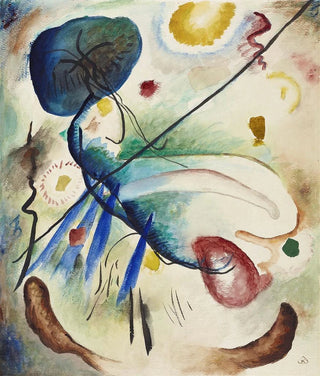Art print | Watercolor with line - Wassily Kandinsky


View from behind

Frame (optional)
Art print Aquatic watercolor with line - Wassily Kandinsky – Captivating introduction
Wassily Kandinsky's "Aquatic watercolor with line" piece stands as a true ode to color and form, capturing the very essence of abstract art. In this work, the artist explores the relationships between hues and lines, creating a vibrant atmosphere that transports the viewer beyond mere figurative representations. The magic of this watercolor lies in its ability to evoke deep emotions while leaving room for personal interpretation. Each brushstroke seems to dance on the paper, inviting introspective contemplation and a journey into the heart of imagination. This artwork, both delicate and powerful, embodies Kandinsky's quest to free art from the constraints of the visible.
Style and uniqueness of the work
Kandinsky's style is distinguished by its innovative approach and desire to transcend the artistic conventions of his time. In "Aquatic watercolor with line," colors intertwine with an airy lightness, while lines—sometimes fluid, sometimes angular—create a dynamic dialogue across the surface of the piece. The artist skillfully plays with contrasts, using warm and cool tones to generate visual tensions that captivate the eye. Every element of this watercolor is carefully considered, demonstrating technical mastery and aesthetic sensitivity that make Kandinsky a pioneer of modern art. His ability to translate complex emotions into abstract forms makes this work an emblematic example of his unique style, where color becomes language and form, expression.
The artist and his influence
Wassily Kandinsky, born in 1866 in Russia, is often regarded as one of the founders of abstract art. His artistic journey is marked by an incessant search for harmony between colors and sounds, an idea he develops in his theoretical writings such as "Concerning the Spiritual in Art." Kandinsky firmly believed that art should go beyond the representation of the visible world to touch the very essence of human experience. His influence extends across 20th-century artistic movements, inspiring generations of artists to explore abstraction.

Matte finish

View from behind

Frame (optional)
Art print Aquatic watercolor with line - Wassily Kandinsky – Captivating introduction
Wassily Kandinsky's "Aquatic watercolor with line" piece stands as a true ode to color and form, capturing the very essence of abstract art. In this work, the artist explores the relationships between hues and lines, creating a vibrant atmosphere that transports the viewer beyond mere figurative representations. The magic of this watercolor lies in its ability to evoke deep emotions while leaving room for personal interpretation. Each brushstroke seems to dance on the paper, inviting introspective contemplation and a journey into the heart of imagination. This artwork, both delicate and powerful, embodies Kandinsky's quest to free art from the constraints of the visible.
Style and uniqueness of the work
Kandinsky's style is distinguished by its innovative approach and desire to transcend the artistic conventions of his time. In "Aquatic watercolor with line," colors intertwine with an airy lightness, while lines—sometimes fluid, sometimes angular—create a dynamic dialogue across the surface of the piece. The artist skillfully plays with contrasts, using warm and cool tones to generate visual tensions that captivate the eye. Every element of this watercolor is carefully considered, demonstrating technical mastery and aesthetic sensitivity that make Kandinsky a pioneer of modern art. His ability to translate complex emotions into abstract forms makes this work an emblematic example of his unique style, where color becomes language and form, expression.
The artist and his influence
Wassily Kandinsky, born in 1866 in Russia, is often regarded as one of the founders of abstract art. His artistic journey is marked by an incessant search for harmony between colors and sounds, an idea he develops in his theoretical writings such as "Concerning the Spiritual in Art." Kandinsky firmly believed that art should go beyond the representation of the visible world to touch the very essence of human experience. His influence extends across 20th-century artistic movements, inspiring generations of artists to explore abstraction.






